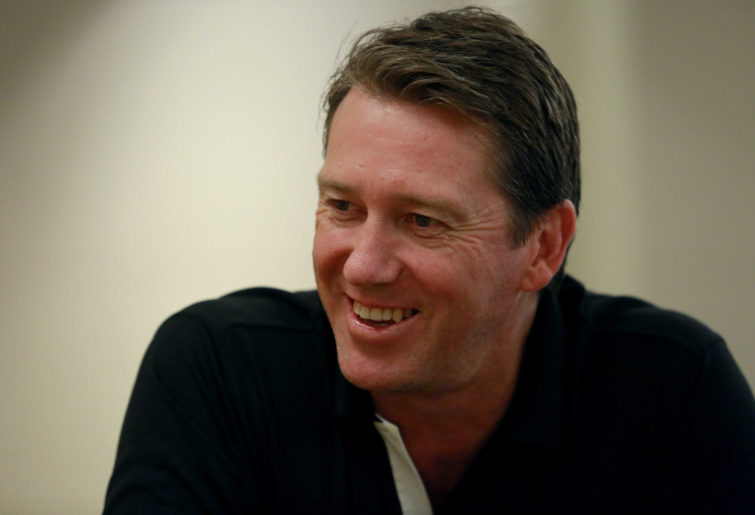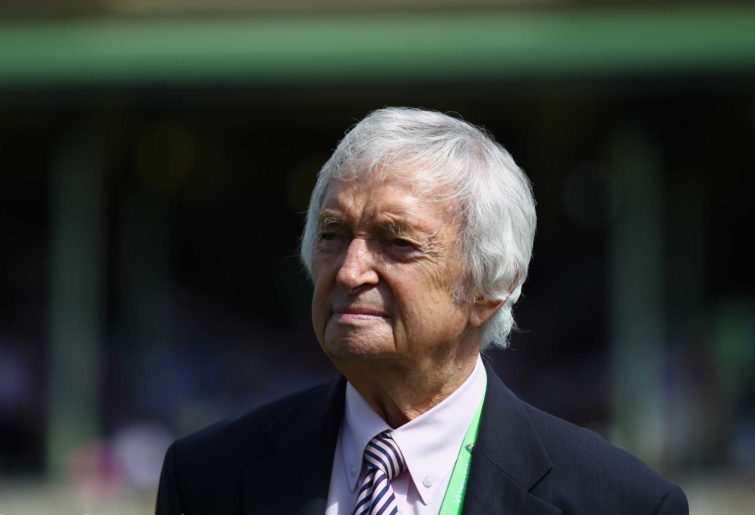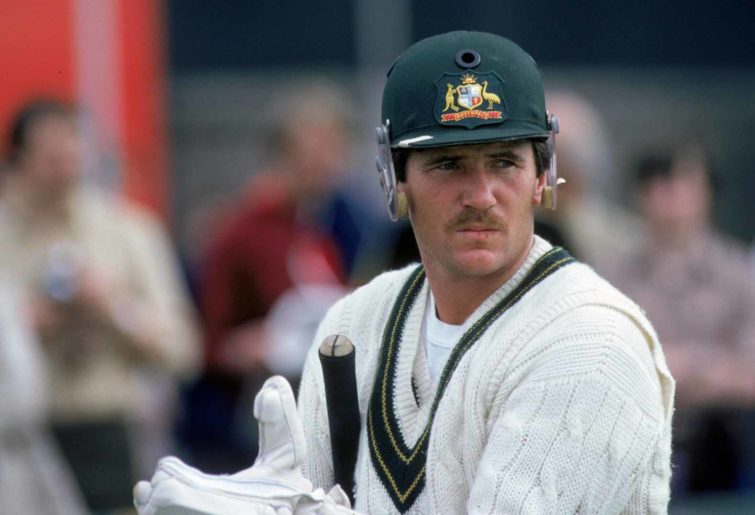“It’s not how, it’s how many.”
Bowlers really do win matches. But sometimes, they do so with the bat. Even a genuine bunny can play a vital role in extending a lead, reducing a deficit, turning a poor score into a respectable one, or forcing a draw.
Each run scored by a tail-ender has the same worth as one scored by a recognised batsman, and sometimes more when it entertains spectators, frustrates opponents or lifts team-mates’ spirits.
Recently I’ve analysed opening batting pairs and then bowlers’ performances against tail-enders. Now, I will assess bowlers’ performances as tail-enders, including their partnerships with higher-order batsmen.
A consistent 26 per cent of all Test runs have been scored after the fall of the sixth wicket, going back 144 years. Each of the last four stands has yielded about six per cent.
While Glenn McGrath averaged only 7.36 himself, his 138 trips to the crease included two century partnerships and two half-century ones.

(Photo by Amal KS/Hindustan Times via Getty Images)
Chuck Fleetwood-Smith scored only five runs at Trent Bridge in 1938, but his support enabled Stan McCabe to amass a magnificent 232, and together they added 77 runs in only 28 minutes for the last wicket.
Who can forget Jason Gillespie’s last innings, in Chattogram in 2005-06? He was promoted to number three as a nightwatchman, while boasting a modest average of 15.64 from 92 innings to that point. The outcome was an undefeated double-century, and a 320-run fourth-wicket partnership with Mike Hussey.
Tail-enders have sometimes successfully staved off defeat, in pairs or in support of top-order batsmen. Think last pairs Brett Lee and Glenn McGrath for four overs at Old Trafford in 2005, and Craig McDermott and Mike Whitney for 23 minutes against New Zealand at the MCG in 1987-88.
Unfortunately, not every heroic tenth-wicket stand gets the outcome it deserves. At Trent Bridge in 2013, Australia lost by 14 runs despite partnerships of 163 between Phil Hughes and debutant Ashton Agar, then 65 between Brad Haddin and James Pattinson.
Previously the side lost to England by three runs at the MCG in 1982-83 after Allan Border and Jeff Thomson added 70, by two runs at Edgbaston in 2005 after Brett Lee and Michael Kasprowicz added 59, and by one run against the West Indies in Adelaide in 1992-93 after Tim May and Craig McDermott added 40.
So which pairs and individuals have enjoyed the greatest success down the order ?
The best pairing of all time
Rather unexpectedly, Rod Marsh and leg-spinner Kerry O’Keeffe clearly have the best record of all lower-order pairs. Their 12 partnerships between 1971 and 1977 for the seventh and eighth wickets averaged 60.09 runs.
Two of their 12 stands exceeded 100, a feat matched only by Steve Waugh and Shane Warne, who batted together 30 times. Four other ones exceeded 50, and their first eight partnerships alone totalled 632 runs. No other duo in Australian history that batted together more than four times, had an average stand in excess of 50 runs. Even average partnerships higher than 40 are rare.

(Photo by S&G/PA Images via Getty Images)
The pairing commenced with a 97-run partnership in O’Keeffe’s debut against England at the MCG in 1970-71, the match in which Bill Lawry famously declared when Marsh was 92 not out. Their highest stand of 168 was made against New Zealand in Adelaide in 1973-74, after coming together with Australia’s score at an uncomfortable 6-232.
Despite O’Keeffe’s career yielding a personal average of only 25.76 with one half-century, he proved to be a valuable batting partner usually at number eight. Apart from his many stands with Marsh, three with Gary Gilmour returned a total of 182 runs, and his only one with Gary Cosier was worth 117. In the Centenary Test at the MCG in 1976-77, he opened the batting in Australia’s second innings after a Bob Willis bouncer had broken Rick McCosker’s jaw.
The best pairing of two bowlers
Those who make up the lower-order do so because seven or more of their team-mates are superior batsmen. However from time to time, a lower-order includes multiple players who would not be out of place a spot or two higher.
Brett Lee and Shane Warne are clearly the most successful pairing, having accumulated 340 runs from ten partnerships at an average of 34.00. Their first two partnerships, both at the WACA and both for the eighth wicket, were 72 against New Zealand and 68 against England. By comparison, no other pair has batted together more than seven times, and averaged more than 26.42 for those stands.

(Greg Wood/AFP/Getty Images)
In terms of total runs scored by one pair of specialist bowlers, the most prolific is Mitchell Starc and Nathan Lyon. To date they have batted together 20 times, for 468 runs at 24.63. Four of their stands have exceeded 50 runs, including one of 87 for the tenth wicket against South Africa at the WACA in 2012-13.
The next most successful pairings are Ray Lindwall and Ian Johnson, Richie Benaud and Alan Davidson, Paul Reiffel and Warne, and Starc and Josh Hazlewood. Lindwall is still the only Australian to have scored two centuries while batting at number eight or lower.
The best pairing of a batsman with a tail-ender
Not surprisingly, Steve Waugh dominates this list. Batting generally at number five during a 19-year career, he regularly achieved sizeable stands with lower-order partners, after numbers six and seven had been dismissed. While he was sometimes criticised for not farming the strike, the results speak for themselves.
He put together 24 separate stands of at least 50 runs, with 15 different tail-enders, and eight of those 24 partnerships yielded a century. The first two matches of the Ashes series of 1989 alone yielded 147 with Merv Hughes at Headingley, and then 130 with Geoff Lawson at Lord’s.
His other notable stands included an unbroken 142 with Shane Warne against New Zealand at the Gabba in 1993-94, 133 with Jason Gillespie in Kolkata in 2000-01, 124 with Andy Bichel in Bridgetown in 2003, and 117 with Paul Reiffel against Sri Lanka in Adelaide in 1995-96.
Waugh averaged 62.33 in stands with Lawson, 49.23 with Reiffel, 41.66 with Brendon Julian, 41.20 with Hughes, 34.22 with Gillespie, and 33.83 with Damien Fleming. Even those with noted rabbit Stuart MacGill averaged 21.60, including one of 88 for the ninth wicket against England at the MCG in 1998-99. Australia ultimately lost that match by only 12 runs.
Steve Smith has enjoyed similar success with the two Mitchells, Starc and Johnson, with average stands of 44.41 and 39.41 respectively.

(Photo by Gareth Copley/Getty Images)
Ricky Ponting achieved equally high figures with Fleming, Gillespie, Lee, Reiffel and Warne, albeit from only rare partnerships.
From earlier eras, Ken ‘Slasher’ Mackay’s partnerships during the 1950s and ‘60s with lower-order batsmen stand out. He averaged 45.62 in such stands with Richie Benaud, and 40.27 with Alan Davidson. Those partnerships included eight that reached 50 runs, of which two reached 100.
While wicketkeeper-batsmen Adam Gilchrist, Brad Haddin and Ian Healy scored many runs batting at number seven, their most sizeable partnerships tended to be with a top-order batsman, rather than with a tail-ender following the removal of all six specialists.
Match-deciding partnerships
Any club-level trundler will be able to relate to this scenario. After toiling away for hours in the field, he finally gets to put his feet up. However his job’s not over, as the top-order collapses. So he has to pad up, and rescue his side. Here are the best ten examples of that situation, ranked by their influence on the match’s result.
Australia versus West Indies, MCG, 1951-52
This is still the only instance of Australia winning a match by one wicket. It was the series’ fourth match, and the West Indies had won the previous one. The home side’s victory target of 260 was a challenging one especially after slipping to 5-147.
Last pair leg-spinner Doug Ring and left-armer Bill Johnston joined forces with 38 still required, after spinners Alf Valentine and Sonny Ramadhin had shared eight of the nine wickets to fall. Each was a 1948 Invincible but a modest batsman, notwithstanding Johnston averaging 102.00 with the bat in England in 1953, when captain Lindsay Hassett famously contrived with opposing captains and bowlers for him to be dismissed only once in 17 innings.
Ring and Johnston not only survived for 35 minutes, but scored the winning runs. Charles Davis wrote of the West Indies that “team discipline fell apart when Johnston and Ring were playing their match-winning last-wicket stand at Melbourne. Bowlers and other fielders changed the field around when the captain’s back was turned. Ramadhin just walked off the field. Goddard withdrew from the next (final) Test, citing ‘nervous exhaustion’.”

(Steven Paston – EMPICS/Getty Images)
Australia versus West Indies, Adelaide Oval, 1960-61
This was the first of four instances to date of Australia forcing a draw with its final pair at the crease, and is the only one in which the partnership lasted more than a handful of overs. The West Indies had won the previous match by 222 runs to level the series at 1-1. The home team was set an unreachable target of 460, commenced the final day’s play at 3-31, and after tea slumped to 9-207.
Left-arm wrist-spinner Lindsay Kline then joined Ken ‘Slasher’ Mackay at the crease and the pair had to withstand Wes Hall, Garry Sobers, Lance Gibbs and Alf Valentine. Some 109 minutes later, Mackay and Kline were still undefeated on 62 and 15 respectively. They withstood 283 deliveries surrounded by close-in fieldsmen, and scored 66 runs together.
It was Kline’s highest score in Test cricket, only six weeks after he had faced the last ball of the tied Test. He never played again for Australia, after returning bowling figures of 0-109 and 0-48.
Australia versus West Indies, Gabba, 1960-61
Arguably the most exciting series ever played in Australia commenced with the most exciting match, made so by a famous last-day partnership. After a decade characterised by slow scoring and dull draws, this game featured almost 1500 runs over five days and ended with the closest result possible.
Despite scoring 505 in its first innings, the home side required a challenging 233 in five hours for victory. When it slumped to 6-92 all appeared lost. Many previous Australian teams would have defended grimly from that point.
However Alan Davidson and captain Richie Benaud had other ideas. They counter-attacked with a seventh-wicket stand of 134 runs in 132 minutes, to take their side to within seven runs of its target.
Unfortunately the final four wickets then fell in six minutes for the addition of only six runs. The match ended with Joe Solomon running out Ian Meckiff with a direct hit from side-on, from the last ball of the match with the scores level. The official attendance for that day was only 4100, but that figure is dwarfed by the number of people who claim to have been there.
England versus Australia, Old Trafford, 1961
Only a few months after the most exciting series played to that point, Australia toured England. With the series level at 1-1, the Ashes were at risk when the home side gained a massive 177-run first-innings lead. When the visitors lost their ninth wicket in their second innings, their lead was only 157.
For the second time in consecutive series, left-handed all-rounder Alan Davidson played a match-deciding innings. Legendary fast bowlers Fred Trueman and Brian Statham returned figures of 0-92 and 1-106 respectively. After off-spinner David Allen had taken four wickets, Davidson hit him out of the attack by taking 20 runs from one over. He scored 77 with two sixes and ten boundaries before Graham McKenzie was finally dismissed for 32. Their stand was worth 98, extending Australia’s lead to a defendable 255.
Captain Richie Benaud then bowled his side to victory, taking 6-70 as England slipped from 1-150 to 201 all out. Australia won by 54 runs, and retained the Ashes with a match to spare.

(Photo by Ryan Pierse/Getty Images)
Australia versus England, SCG, 1884-85
In the 19th Test ever played, and at a time of poor pitches and low scores, Australia’s first significant tenth-wicket partnership was recorded. Captain Hugh Massie won the toss and elected to bat in front of only 2000 spectators. Unfortunately at the end of the first day’s play his team’s score was just 8-97 from 107 four-ball overs, in front of only 2000 spectators.
The following day, a Saturday, the crowd swelled to 10,000. It saw the ninth wicket fall for the addition of only four more runs, reducing the team to 9-101. This brought Ted Evans to the crease to accompany Tom Garrett, great-grandfather of Midnight Oil lead singer Peter Garrett.
Garrett scored an undefeated 51 and Evans 33. It was each player’s highest score in a Test match. Together they added 80 priceless runs in 95 minutes for the tenth wicket, to take the team’s total to a very respectable 181. It went on to secure a rare victory by only six runs, with Fred Spofforth taking 6-90 in England’s second innings of 207.
West Indies versus Australia, Bourda Ground, 1984
In this series’ first match, Australia was clearly the underdog. It was rebuilding after the retirement of Greg Chappell, Dennis Lillee and Rod Marsh. A formidable West Indies side had just defeated India easily in back-to-back home-and-away series.
Batting first, Australia recovered from 9-182 against an attack comprising Joel Garner, Wayne Daniel, Winston Davis and Roger Harper. The recovery was due to Tom Hogan and Rodney Hogg adding 97 valuable runs in 149 minutes for the tenth wicket, to take their team’s score to 279. Hogg’s 52 was his only half-century and featured the only six of his career, while Hogan’s 42 not out was also his highest score.
Kim Hughes was eventually able to declare its second innings at 9-273 and set the home team 323 for victory. By the match’s conclusion it had reached 0-250 from 61 overs, with Gordon Greenidge and Desmond Haynes each scoring an undefeated century. Had Hogan and Hogg not compiled such a large partnership, the hosts would have easily won the match. After drawing the following match as well, thanks to Allan Border’s undefeated 98 and 100, Australia lost the series 3-0.

(Adrian Murrell/Getty Images)
Australia versus India, SCG, 2007-08
An outstanding partnership between Andrew Symonds and Brad Hogg was overshadowed by umpiring controversies, a last-over victory and the Monkeygate scandal. Australia slumped to 6-134 yet finished the first day’s play at 7-376, after they added 173 runs for the seventh wicket in only 36.2 overs.
Symonds scored a career-high 162 not out and was named player of the match, but later admitted to being caught behind when on 30. Hogg’s 79 was also his highest score. The game ended with Michael Clarke taking 1.5-0-5-3 including the last wicket with only nine minutes to spare, and India threatening to fly home should Harbhajan Singh be suspended.
Australia versus England, Adelaide Oval, 1907-08
This match featured the highest stand by any pair after the sixth wicket has fallen. Specialist batsman Clem Hill and debutant Roger Hartigan added 243 runs for the eighth wicket in 40-degree heat, a record that still stands 113 years later. The match-winning partnership took their team from 7-180 to 8-423, after commencing with Australia’s lead only 101.
Hartigan scored 116 batting at number eight, and his next match also proved to be his last. A flu-ridden Hill scored 160 at number nine, having not been expected to bat at all. Being frequently violently sick beside the pitch earned him the nickname Clement ‘Ill’.
Australia versus England, SCG, 1884-85
This match featured only the sixth partnership ever in excess of 100 runs, and the first by other than a top-order pair.
In response to England’s challenging 269, the home side had collapsed to 7-134 and faced the prospect of a large first-innings deficit. However from number eight renowned hitter George Bonnor scored 128 in only 115 minutes with three sixes, and he was ably supported by Sammy Jones, who made 40. Together they added 154 runs for the eighth wicket to give Australia a crucial lead.
It ultimately won the match by eight wickets after Joey Palmer and Fred Spofforth dismissed the tourists a second time for only 77.
Australia versus Pakistan, SCG, 2009-10
This match took a roller-coaster course, from the time that Australia was dismissed for only 127. Pakistan replied with 333, for a seemingly unbeatable lead of 206 runs. When the home side reached 8-257 in its second innings, its lead was only 51 and the match appeared all but over.
Peter Siddle then joined Michael Hussey at the crease, and the pair added 123 runs for the ninth wicket from 45.4 overs in 217 minutes. Hussey extended his score to an unbeaten 134, while Siddle reached 38 after which Doug Bollinger fell for a golden duck.
Pakistan’s victory target was 176, with more than four sessions in which to score them. It imploded, being dismissed in only 38 overs for 139, to fall 36 runs short with more than a day to spare.
If not for strong suspicions regarding Pakistan’s performance during the last two days, this recovery would have earned a much higher ranking. A number of batsmen fell to skied shots from Nathan Hauritz’s bowling, while subsequently team members Salman Butt and Mohammad Asif were found guilty of spot fixing in a Test at Lord’s played eight months later.




































































































